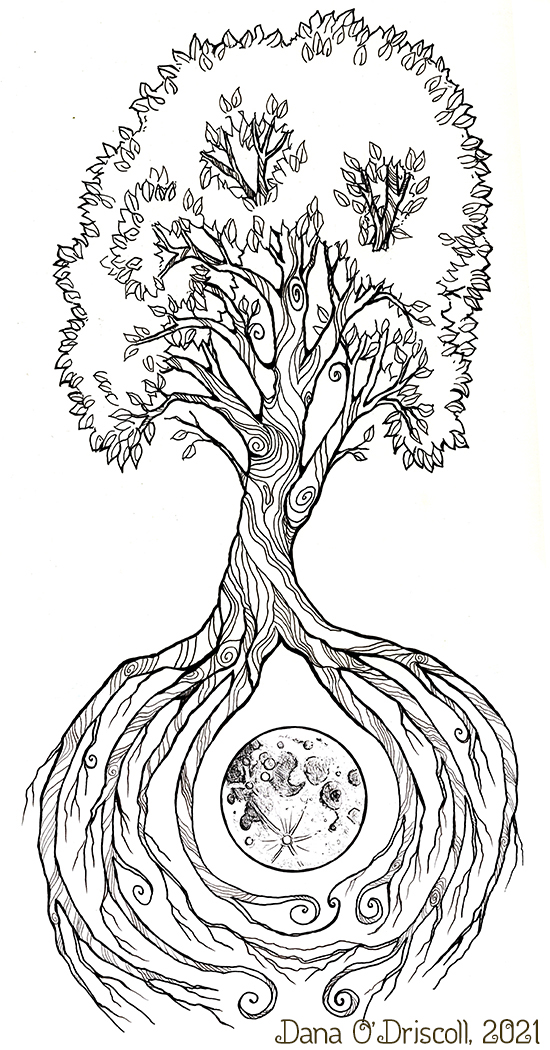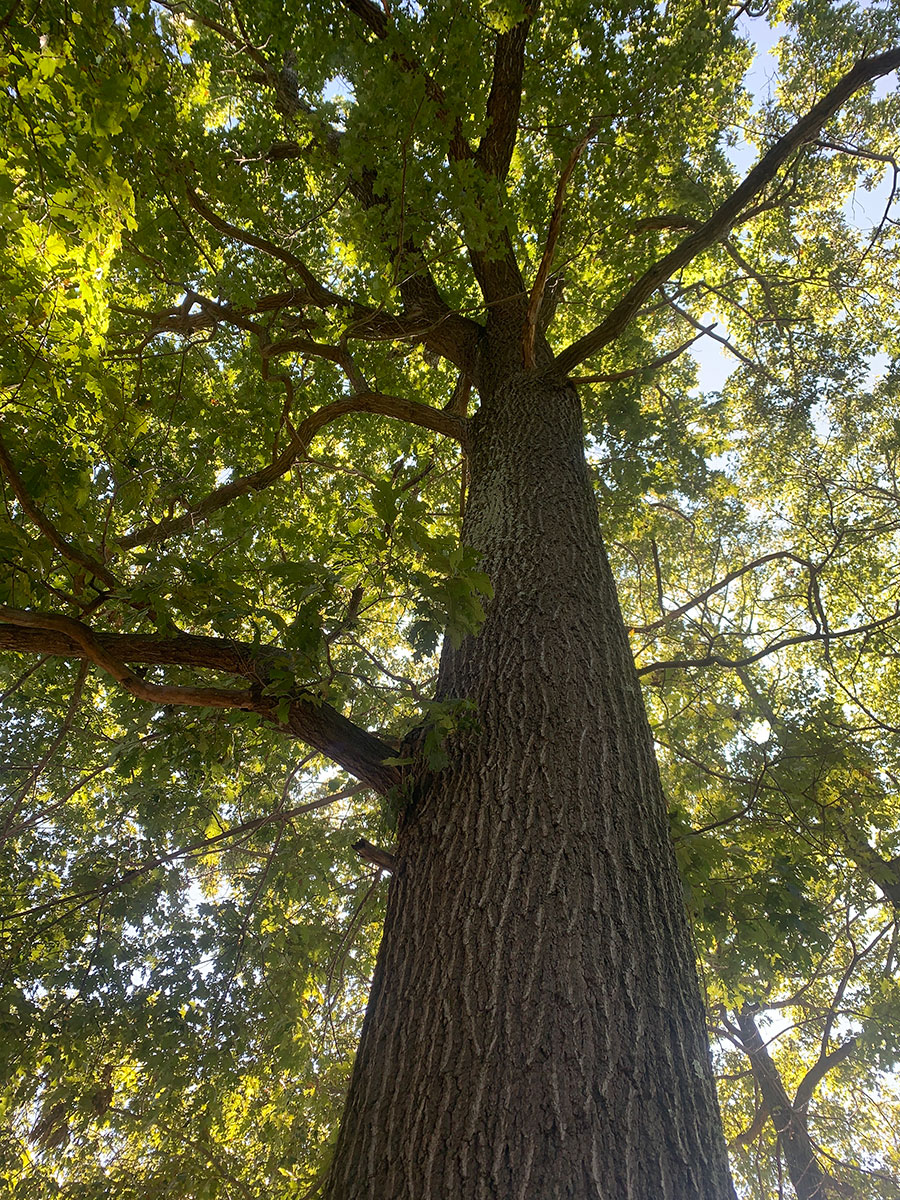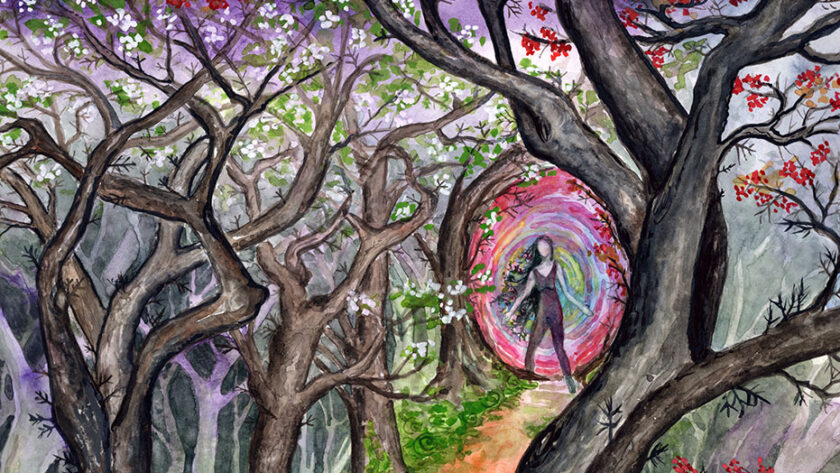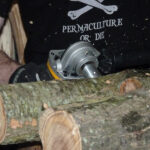In the western esoteric traditions, and traditions tied to them, like druidry, initiation is a powerful method of transformation and energetic work. While features of initiation and their overall goals vary widely by tradition, many initiations do follow some basic patterns, and those are worth exploring. In Inside a Magical Lodge, John Michael Greer notes that the outcome of initiations are to enact specific and desired patterns of change in a person and to connect new members to the group and to the group’s overall egregore (that is, the energetic patterns that a group collectively creates). The initiation then, as he writes, is the magical framework that is put in place in a candidate from which all other things derive.
I believe that we can apply this same practice to working and reconnecting with nature, and today, I’ll share my thoughts on initiations through nature–tree initiations. A tree initiation often results in a very deep, mutually beneficial relationship between you and the trees. Nature and humans cultivated such relationships for most of human history; this is obvious from our mythology, from our own history, and from existing indigenous cultures. It has only been in the last few centuries that those of us in western industrialized cultures lost our ability (and desire) to deeply connect with nature.

Tree initiations are one way of helping us to re-establish those deep bonds with a specific kind of ceremony. In the same way that some dedicate themselves to working with a particular deity, I have found great value in connecting myself deeply with certain tree species. One of the ways into this work is through initiation. That is, you are making a conscious commitment to connecting with a tree or tree species in a sacred manner. You can think about this as a magical act that will help jumpstart a much deeper relationship to the tree and to the species.
With tree initiations, this goes beyond a friendly acquaintance, but rather, is a gateway into the deeper mysteries of nature and of that particular tree or species of trees (or plant, for that matter). A tree initiation, then, is a way of establishing a life-long relationship with a tree species, in the same way, that one you are initiated into a druid order or other magical group, you typically will always be a member of that group as long as both you and the group exist. This kind of ceremony can allow you to connect with the trees in a way. Like any other initiation, the initiation works deeply within you, and through you, and has long-term and lasting effects. Perhaps what I write here is appealing to you, and you have been called to a specific tree, you will find it of use to continue to use some of the strategies I include here. I will also note that while I am describing “tree initiations” you can do the same thing outlined here with plants and other features of nature.
Please note that this is a post in my longstanding series on working with trees in a sacred manner. Earlier posts in this series include finding the face of a tree, working with trees on the outer planes, working with trees on the inner planes, helping tree spirits pass, offering tree blessings for abundance and wassailing trees, considering the role of the seasons and seasonal the breath of the earth in tree work, cultivating deep connections with trees, connecting to trees in urban settings, working with the Nywfre/energy flows of trees through sap flows, deepening relationships with trees, seeking out and working with grandmother trees, cultivating reciprocity in tree relationships, creating intuitive tree sigils and tree magic, and witnessing the death of a tree. I list these out here because much of the preparation for doing a tree initiation, which is a very advanced practice, can be found in these other posts where you get to know trees, support them, and work with them in various ways.
Druid Tree Workings: An Initiation from the Trees
Before we can delve into the specifics of tree initiations, I’m going to start by describing some features of initiations so that we can see how we might begin to craft tree initiations:
Preparation. There is typically a period of time when the candidate prepares for their initiation. The specifics of this vary widely. This might be a longer period of time: like a period of learning and growing in that tradition, a period of growing up (as in years). But there is usually also some distinct time set aside for the preparation for that exact ceremony (a silent vigil, period of meditation, special bath, etc). This certainly applies to tree initiations; there often is a long period of preparation (and you might not even know you have been being prepared) while you learn and connect with your tree. Most of the work that I outlined in my previous posts on Druid Tree Workings (see full list above) is much of the prep work for such initiatic work.
Timing. Timing often plays a critical role in initiations. For coming of age rituals and initiations that mark the passage of an important life event, the timing of them is obviously based on marking a key point in someone’s life. For initiations into magical traditions, path of the sun in the wheel of the year, the placement of the stars, or the phase of the moon may be important (e.g. having an initiation on the equinox). For tree initiations, paying attention to the seasonal cycles is particularly critical. I have found that different trees have their high energy times at different points; apple is most powerful when she is full fruit, witch hazel is most powerful in late fall when she is blooming; and maple is most powerful in early spring when her sap is running, as three examples. See this post earlier in the druid tree workings series for some general timing suggestions on when trees have their highest energy (because that is a very good time to do this work).
Roles: Common roles include the Initiator(s) who are performing the initiation, the candidate (those being initiated), and, depending on the initiation, observers/community who are there in support of the person being initiated. Anyone with any role in the initiation (even spectator) take part in the experience, and all are changed by it.

Receptivity. Typically, initiations involve somehow putting a candidate into a receptive state so that other work can be done. This can vary widely; in indigenous cultures, fasting, not sleeping for a period of days, and/or ingesting psychotropic mushrooms are ways to place the candidate in a receptive state; in other magical traditions, the candidate may be blindfolded, exposed to startling noises, or other things to get them out of their normal working state. With tree initiations, I believe that this receptive state comes after basic energy exchange and sitting in quietude with the tree.
A fundamental shift of some kind. The whole point of initiation is to enact some change in the candidate and to mark some important milestone; as such, effective initiations are accompanied by some fundamental shift. The shift may be subtle or dramatic, but it is present. The lack of such a shift likely means the initiation “didn’t take” due to a variety of reasons (e.g. the candidate is not ready for that kind of shift).
Now that we have some idea of the features of initiations more broadly, we can begin talking about specific tree initiations.
Preparation
Just like any other initiatory experience, it is important to prepare for a tree initiation for a period of time. For one, both the tree and you have to be ready for it and willing for it to happen, and that isn’t like putting a date on a calendar. Rather, this should be something that you come to understand over a period of time, that you are called to do or a specific tree you feel called to really deeply work with. Sometimes, the preparation for initiation can take years. Trees work on their own time and it may not be your time.
I have personally found, and this might be different for you, that tree species will call to you. A particular tree might be your main contact (e.g. the oak in your back yard) but you will find yourself as you are out on the landscape continuing to be drawn to the same species. Over time, this is a species you might end up having an initiatic experience.
Establishing a relationship. Most trees and plants want to have relationships with us; they miss our ancestral connections, and they are looking to re-establish them. The first step on this journey is working with trees, recognizing that they are our elders and that they have much to teach us. Practicing respectful communication with them, recognizing and honoring their agency, and a lot of other basic steps (again, outlined by my other posts). If you are going to prepare for initiation with a tree or ask a tree for such an initiation, you need to lay the foundation and groundwork. This can take time, perhaps a lot of time, but it is time well spent.
Observe, interact, and commune. As you are preparing for this work, you want to spend time with your tree or tree species as much as you can. Observe your trees in different seasons. Interact with your trees. You might find that a species all has a particular mentality, although individuals differ (think about this like culture–all people from certain cultures share certain features but are still individuals). Spend a lot of time talking with your tree, getting to know your tree, hearing their story, and sharing yours. Find out what you have in common and how you might work deeply together.

Build understanding. Its also a great idea to learn about your tree. Find out information on the tree’s ecology, role in the ecosystem, growth habits, how tall it grows, how long it lives, what you can make from it. Get a bit of the wood and see how it is to shape it. Learn how to make medicine, cordage, food, drink, whatever you can from the tree. I have a whole series on druid trees that you can draw upon if you are anywhere near my ecosystem (see the top of this post for a complete list).
Establishing commitment. Once you’ve done that preliminary work, there will be a time where your work deepens, where you grow committed to each other. It is at this point that crafting a tree initiation ceremony will be appropriate.
Planning Your Initiation
Once you feel it is appropriate and you get a clear signal from your tree, you can begin planning your tree initiation, a ceremony you craft together with the tree that helps connect you deeper and leads you into the deeper mysteries of the living earth. I’m going to now offer some possibilities from my experience, but understand that each of these ceremonies are different. Above all, work with the tree itself and hear what guidance they have for you.
Taking the Tree Within
Unless the tree is poisonous (like Yew), I have found that taking the tree into yourself in some way and offering something in exchange is an important part of this process. Your tree research should have revealed if the tree is poisonous or if it was used as medicine/food. In my ecosystem, few actually are poisonous and most have edible leaves or needles, but it might be different in yours. It also might be the case that part of the tree can be eaten but the rest is poisonous (for example, black locust flowers/beans can be eaten safely). Or it might be that eating it may require some preparation (certain tannin-rich acorns). Many of the hardwood trees (maple, birch, linden) have leaves that are edible, especially earlier in the season when they are young and tender. If it is poisonous, obviously, don’t eat it. If it isn’t, poisonous, however, I would suggest that you start consuming small parts of it (with permission and with an offering). This allows part of the tree’s life force and energy to work its way into your physical body.
Always listen to what the tree tells you regarding whether or not you can take a piece of it. Honoring that tree’s request, and not taking something if it is not allowed/offered, is one of the most important and meaningful ways of building a relationship. Many trees have been abused by humans, have lost their elders to humans, and some can take time before they are willing to give.
Here are a few possibilities:
- Eating leaves, flowers, seeds, nuts. You can eat flowers, leaves, nuts, and seeds fresh off the tree certain times of year. Each tree has a different cycle. May tree leaves and flowers are edible (and delicious when young and tender). Nuts can also be enjoyed. Flowers and nuts are very potent because they contain the lifeforce of the tree.
- A Tree Tea. Many trees make a pleasant tea that you can drink. I enjoy conifers for this quite a bit—eastern hemlock, white pine, blue spruce all make delightful teas. To make a simple needle or leaf tea, I will gather the leaves/needles (leaving an appropriate offering) and pour boiling water on it and let it sit for a while (30 min or longer for needles, 10-15 min for tree leaves or flowers). If you want, you can instead use sun tea and allow the sun to heat up the needles. Strain and add a bit of honey for an amazing treat.
- A Tree Bud or Leaf Essence. Some trees are not healthy for you to eat or don’t want to be damaged or have their parts removed, but you can create a flower or leaf essence. You simply go out on a sunny day with a bowl of spring water and put the bowl right up to the leaf/flower and let the leaf/flower sit in the bowl of water for a time (use your intuition). This creates a “mother” essence that you can then water down and store (some people put a bit of brandy in their essences to preserve them). And you can take the “mother” essence for a long period of time.
- Tree Sap. Some trees (walnut, birch, hickory, various maples) also have sap that runs and that can be tapped in the spring. With permission and copious offerings, you might be able to tap a tree and drink their sap directly (all of the above saps can be drank directly or boiled down into syrup/sugar). This is an extremely powerful exchange (you are essentially drinking the lifeblood of the tree) and should be done with respect and honor. To drink their sap, you don’t even need to tap them—I remember a year I was harvesting birch branches. It is best to do this in the spring right as they are budding. I harvested a branch from one tree and it was still running. I sat under that branch spot and it dripped every 15 seconds or so, and I allowed it to drip right in my mouth for a time and then made an offering (you know what!) to the tree in thanks. Don’t waste a drop!
- Tree Resin. Some trees also produce an edible resin (like white pine) that you can consume with great care. White pine is the tree I most frequently do this with; again, this is the lifeblood of the tree and should be done only with deep respect, permission, and offering.
All of these offer possibilities to take the tree within, and much deeper work can manifest once we have a stronger physical connection to the tree.
Discover the tree’s time of power

In order to perform the tree initiation, you will need to discover the tree’s time of power during the year. Most deciduous trees are in their power at some point in the light half of the year, while conifers may have a longer time you can work with them. When is this tree at the height of its power? What I mean by this is–when is this tree at the peak of its vitality and presence on the landscape? For example, Maples has two major times of power–when they are flowing in late winter/early spring and when they are in full fiery form in late fall. Oaks seem to be in power throughout the light half of the year–once they have a full crown of leaves and are perhaps at the height of their power at the summer solstice and into the fall as they are dropping thousands of ripened acorns. I’ve found most nut-bearing and fruit-bearing trees seem to be at their peak when those nuts and fruits are ripening and falling. You can intuit this and ask the tree.
The point here is that you want to perform your ceremony at a time when both you and your tree are at their peak (e.g. no good will come of you trying to perform a ceremony with a maple tree at the winter solstice!)
Exchange and offering
You want to think about what exchange you will make, what you will offer the tree. While a physical offering here can be used, I would recommend some kind of longer offering (e.g. I will gather your nuts and plant them in places each fall). Here, the exchange should be something more meaningful (your time, energy, and service) for this tree.
Journey, lessons, or teachings
As part of an initiatatic experience, you will want to create space for direct communion with the tree. Depending on who you are and what methods you use, this part can vary but could include: an open conversation with the tree, meeting the tree on the inner planes and having a spirit journey (see more here), using divination tools to receive messages from the tree, or using sacred dreaming to receive messages. Create space for these lessons and teachings from the tree (and continue to create space for them as time passes beyond your initiation).
Finding the right space
Obviously, you also need to seek out the right place to hold your initiation ceremony. This should be somewhere private where you can be near the tree species. This might be easy for some, and for others, you might have to do a bit of searching. Consider this part of the process!
Putting it all together: Crafting Your Ceremony
Your ceremony will obviously be unique to you, so I cannot give you a specific ceremony here, but I can offer what one may look like. If we put the various pieces above together, here is one option. This is for a sugar maple tree in the fall.
1. In the space you selected, set up your space in any way you feel is appropriate. In our sample ritual with a maple tree (in fall), this would include making a mandala of leaves around the base of the tree and creating an altar in front of the tree.
2. Open up a sacred grove in the space you selected, near a tree that you want to have a tree initiation with. (I would use AODA’s solitary grove opening for this purpose).
3. State your intentions for the ceremony and give space for the tree to offer their own intentions (see last week’s post!)
4. Take the tree within you in whatever manner specified. For our sugar maple ritual, this would be a tablespoon of maple syrup.
5. Go into a deep meditative state, meeting the spirit of the tree, and asking the tree to take you on a journey and offer you initiation and teachings
6. Make a commitment and an offering to the tree (of time, energy, etc). Make sure to do something during the ceremony to begin that offering and commitment. For example, you might sing a song to the tree (I have a maple song I would sing) and then make an offering of liquid gold to the tree as well as an herbal blend.
8. Close the ceremony, ground, and journal about the experience.
This is just one of many examples that you could use–the point being that you are carefully crafting a ceremony to bring you much closer to the sacred maple tree. The last thing I’ll share is that sometimes these initiations aren’t planned–they simply happen!
PS: The Druid’s Garden blog will be going on hiatus for a few weeks while we do a site upgrade. We will be moving to a new domain and doing some scheduled website maintenance, so you may also experience some intermittent downtime. No worries–the blog will be back up and running soon!




Hello, how can we contact you?? I have looked everywhere and could find any information about that.
Hi Laruent, you should see a “contact” form under “About the druid”. Thanks
[…] Druid Tree Workings: An Initiation from the Trees — The Druids Garden […]